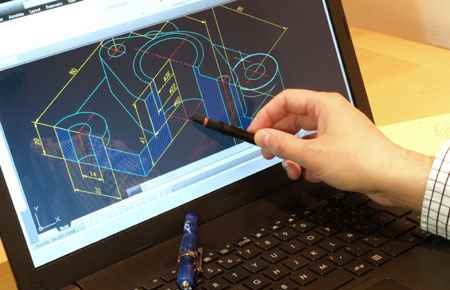
Summary
Drafters use software to convert the designs of engineers and architects into technical drawings.
What they do
Drafters use software to convert the designs of architects and engineers into technical drawings. Most workers specialize in architectural, civil, electrical, or mechanical drafting and use technical drawings to help design everything from microchips to skyscrapers.
Drafters typically do the following:
- Design plans using computer-aided design (CAD) software
- Work from rough sketches and specifications created by engineers and architects
- Design products with engineering and manufacturing techniques
- Add details to architectural plans from their knowledge of building techniques
- Specify dimensions, materials, and procedures for new products
- Work under the supervision of engineers or architects
Some drafters are referred to as CAD operators. Using CAD systems, drafters create and store technical drawings digitally. These drawings contain information on how to build a structure or machine, the dimensions of the project, and what materials are needed to complete the project.
Work Environment
Although drafters spend much of their time working on computers in an office, some may visit jobsites to collaborate with architects and engineers.
How to become a Drafter
Drafters typically complete education after high school, often through a program at a community college or technical school. Some programs lead to an associate of applied science in drafting or a related degree. Others result in a certificate or diploma.
Drafters typically need an associate of applied science in drafting or a related degree from a community college or technical school. Some drafters prepare for the occupation by earning a certificate or diploma.
Programs in drafting may include instruction in design fundamentals, sketching, and computer-aided design (CAD) software. It generally takes about 2 years of full-time education to earn an associate’s degree. Certificate and diploma programs vary in length but usually may be completed in less time.
Students frequently specialize in a particular type of drafting, such as mechanical or architectural drafting.
High school students may begin preparing by taking classes in mathematics, science, computer technology, design, computer graphics, and, where available, drafting.
The American Design Drafting Association (ADDA) offers certification for drafters. Although not mandatory, certification demonstrates competence and knowledge of nationally recognized practices.
Pay
The median annual wage for drafters was $56,830 in May 2019. The median wage is the wage at which half the workers in an occupation earned more than that amount and half earned less. The lowest 10 percent earned less than $35,920, and the highest 10 percent earned more than $87,720.
Job Outlook
Overall employment of drafters is projected to decline 4 percent from 2019 to 2029. Employment growth will vary by specialty. (See table below.)
Expected employment decreases in manufacturing and engineering services will more than offset the small increases in construction. These decreases will be driven by the use of computer-aided design (CAD) and building information modeling (BIM) technologies, which allow engineers and architects to perform many tasks that used to be done by drafters.
Similar Job Titles
Architectural Designer, Architectural Drafter, Architectural Draftsman, Architectural Technician, CAD Technician (Computer-Aided Design Technician), CADD Operator (Computer-Aided Design and Drafting Operator), Detailer, Drafter, Draftsman, Truss Designer, Aeronautical Drafter, Electrical Computer Aided Design and Drafting Technicians
Related Occupations
Geographic Information Systems Technician, Cartographer and Photogrammetrist, Civil Drafter, Civil Engineering Technician, Commercial and Industrial Designer
More Information
The trade associations listed below represent organizations made up of people (members) who work and promote advancement in the field. Members are very interested in telling others about their work and about careers in those areas. As well, trade associations provide opportunities for organizational networking and learning more about the field’s trends and directions.
- Accrediting Commission of Career Schools and Colleges - ACCSC's mission is to ensure quality education that enhances student success in the workforce. Check out the Student Corner section of the website.
- American Design Drafting Association - The American Design Drafting Association is an international non-profit, professional membership and educational organization developed by a dedicated and enthusiastic group of oil and gas piping drafters who were involved in various phases of design drafting. There is an abundance of information for students as well as educators on the website.
- International Code Council - This Council is the leading global source of model codes and standards and building safety solutions that include product evaluation, accreditation, technology, training, and certification. The Code Council's codes, standards, and solutions are used to ensure safe, affordable, and sustainable communities and buildings worldwide.
Magazines and Publications
Video Transcript
Drafters turn designs for buildings, bridges, and gadgets into fully realized drawings that can be manufactured and built. Drafters use computer-aided design software to convert the sketches and specifications made by architects and engineers into technical drawings. They typically specialize in one area: Architectural drafters draw architectural and structural features of buildings for construction projects. These workers may specialize in a type of building, or in a particular type of material, such as steel or reinforced concrete. Civil drafters prepare topographical maps used in construction and civil engineering projects, such as highways, bridges, and flood-control projects. Electrical drafters create wiring diagrams that other workers use to install and repair electrical equipment and wiring in power plants, electrical distribution systems, and residential and commercial buildings. Electronics drafters produce wiring diagrams, assembly diagrams for circuit boards, and layout drawings used in manufacturing and to install and repair electronic devices. Mechanical drafters prepare detailed layouts for a wide variety of machinery and mechanical tools and devices. These layouts indicate requirements needed for assembly. Although drafters spend much of their time working on computers in an office, some visit jobsites to collaborate with architects and engineers. Most drafters work full time. Drafters generally need to complete a certificate or associate’s degree at a technical institute or community college.
Content retrieved from: US Bureau of Labor Statistics-OOH www.bls.gov/ooh,
CareerOneStop www.careeronestop.org, O*Net Online www.onetonline.org